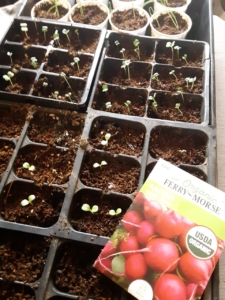MAINE-LY GARDENING: Getting a head start on gardening

 by Jude Hsiang
by Jude Hsiang
Starting seeds indoors is easy, economical, and fun. Most garden seeds can be planted in April and ready to transplant outdoors when the danger of frost is past. If you haven’t done this before, start small with one or two of your favorite vegetables or flowers. Young children can plant larger seeds like beans, which are easy for tiny hands. Older kids can grow their favorites. When I was 6 years old my father gave me a 29-cent packet of radish seeds. I didn’t like radishes, but he explained that I could offer to sell them to a neighbor’s restaurant. Back then the price of a small bunch of radishes was 35 cents. I’ve been gardening ever since.
Seeds can be started in small containers 2-3 inches deep and punched with a few drainage holes: yogurt cups, cut off bottoms of milk cartons, even egg cartons. You will need a soilless planting medium which will be free of weed seeds and disease organisms found in yard or garden soil. While at the store you could buy trays of plastic six-packs for your seeds if you don’t have little containers at home. They can be reused many times with yearly disinfecting using one part bleach to nine parts water. Seeds have all the nutrients baby plants need, so fertilizer isn’t needed.
Soilless planting mediums are water resistant, so you’ll want to wet it thoroughly – mixing and squishing until it’s damp but not soggy – before filling your containers. The seed packet or catalog will show how deep to plant. Very tiny seeds often require light to germinate and so aren’t covered. Set the containers on a tray to catch the drips and put them in a warm place – the top of the refrigerator or other spot out of the way of pets or small children. Seeds take different lengths of time to germinate – another opportunity for young scientists to keep records.
Covering them lightly with a layer of plastic wrap, or the clear plastic covers sold for seed starting trays will keep them warm without drying out. A light watering with lukewarm water when the surface of the planting medium is dry will be all they need. Too much water can cause a fungal disease called “damping off.”
Once the little seedlings have appeared, watch for them to develop their first true leaves, which often look different than the first “seed leaves.” Find a sunny window for them. They’re likely to get leggy as they reach for the sun but turning them each day will help. Move the plants away from the window on very cold nights.
When the second set of true leaves opens, the seedlings can be thinned to about an inch apart. You can give them a little fertilizer at half the rate given on the package. If they are getting crowded, transplant them into larger pots. Hold them by a leaf, as they are still very delicate and can’t survive a damaged stem.
Mid-May days are warm enough to “harden off” the seedlings by adjusting them to the outdoors. Set them in an area protected from strong sunlight or breezes such as on a porch or under a shrub for a few hours a day and increase the time over a couple of weeks. Around the first of June when the risk of frost is over, transplant them into their garden spot or larger containers. Water them well.
More ambitious gardeners can start more seeds and try some fussier plants by spending a moderate amount of money to provide better light and heat. Special heat mats help germination by heating from the bottom and are only needed until the plants have popped up. (Do not use heating pads or electric blankets for this!)
Light can be enhanced by setting up fluorescent shop lights and using a timer set for 16 hours a day. One “warm” bulb and one “cool” bulb combine to give the range of light wavelengths needed by seedlings. Shop lights are hung from chains that allow them to be adjusted to 2-4″ above the tops of the seedlings. Specialized, and more expensive, “grow lights” have a wider wavelength range needed for flower production, but not seedlings. It’s best to talk to a supplier of garden equipment as not all brands of lights aren’t equal. The University of Maine Extension can provide more tips on successful seed starting and all gardening topics.
Whether a few marigold seeds or two dozen tomatoes, it’s very satisfying to watch over the seedlings that promise a bountiful summer.
Responsible journalism is hard work!
It is also expensive!
If you enjoy reading The Town Line and the good news we bring you each week, would you consider a donation to help us continue the work we’re doing?
The Town Line is a 501(c)(3) nonprofit private foundation, and all donations are tax deductible under the Internal Revenue Service code.
To help, please visit our online donation page or mail a check payable to The Town Line, PO Box 89, South China, ME 04358. Your contribution is appreciated!


Leave a Reply
Want to join the discussion?Feel free to contribute!